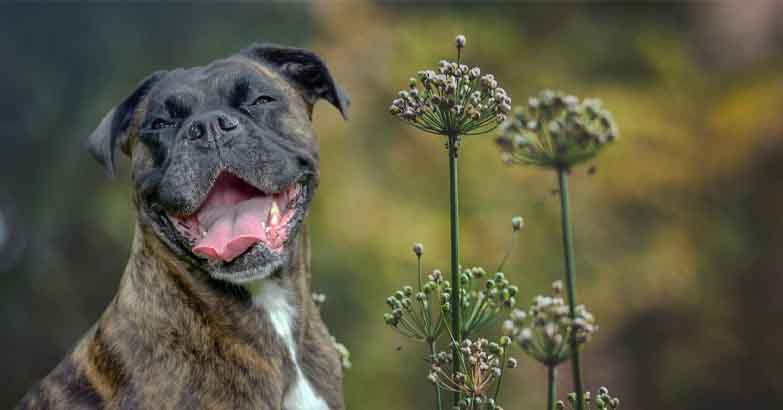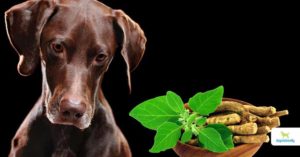As the demand for herbs is on the rise, there is an ever-increasing chance that the herbs you buy are no longer organic, as the manufacturers use all available methods to maximize their production. In addition, many owners complain that herbs no longer have the same efficacy as in the past. This is because of adulteration, the use of inorganic chemicals to maximize production, and poor storage, which leads to fungal and bacterial degradation.
RELATED: How pesticides get into your dog’s food …
The answer to all these problems is to design a medicinal herb garden so you can grow these herbs at home … then store them in adequate conditions to prevent any loss of efficacy. Many people try to grow herbs at home but are unaware of the ins and outs of herb gardening; so don’t achieve optimum yields.
The guide below can help you nurture organic herbs at home and store them properly. Then you can use your own herbs for your dog and your human family.
Garden Design
Planning a garden is challenging and mostly overwhelming for a beginner. There are many things to keep in mind before designing a garden. Start small, is my best advice for an amateur herb grower. Garden design is the first and crucial step toward creating a sustainable herb garden. The following table shows the pros and the cons of different garden designs.
| Type of Design | Description | Pros | Cons |
| 1. Design by plant use | Known as a pharmacy garden, here the herbs are grouped on the base of their effects on systems such as digestive, respiratory etc | Herbs can be easily identified by the beginner.· As herbs are grouped on base of system, easy to make a medicine. | Can be impractical. Design may not meet the optimal requirements of individual plants. Few herbs grow while the rest do not. |
| 2 Design for beauty | Plants are grouped for aesthetic appeal, with color, shape, and texture of flowers and plants kept in mind to give a good look to the garden. | The garden looks beautiful. | Again, different requirements of individual plants mean less optimal yield.· Seasonal blooms and shedding patterns can ruin the beauty of the garden. |
| 3 .Design by plant meeds | Herbalists keep in mind the specific requirements of plants to ensure maximum yield. | A practical method that achieves maximum yield can be achieved. Plants can be protected from attacks of microorganisms and insects. | Requires labor and knowledge of plant needs. |
RELATED: Herbal first aid for your dog …
Conditions to Consider
Once the design has been finalized, certain important factors need to be evaluated before the herbs are planted: Soil, Air, Water, Sun (SAWS).
- Soil: The soil type is very important as soil holds water and minerals. Before planting anything, rest your soil to get an in-depth analysis of the type and presence of minerals in the soil. Soil can be sandy, rocky, soft, and viable. Compost should be added to the soil every spring and autumn to increase organic matter, fertility, and the water-holding capacity of the soil.
- Air: Just as humans need air to breathe, the exchange of air is critical for the health of the plant. Many gardeners make the mistake of planting herbs close to each other for a better look. Plants must be kept at an adequate distance from each other to ensure a supply of air and exposure to the sun.
- Water: Plants need water to grow. The quantity of water for each plant is very important. Some plants require more water, while some don’t want their feet to be wet. That’s why it’s best to plan a garden design grouped by plants with similar needs. In this case, those plants that require more water must be separated from those consuming less water. Research each plant’s water needs to make sure that each plant gets what it likes.
- Sun: Most herbs require 6-8 hours of sunlight. But some plants are shade loving. To ensure maximum sunlight, the garden must not be under trees that block sunlight. Shade-loving plants can be planted in pots and kept on the porch or used as hanging baskets. Examples of sun-loving and shade-loving plants are …
| Sun loving | Shade Loving |
| Asclepias Basil Calendula Catnip Chamomile Costmary Dandelion Datura Echinacea Elecampane Geranium Honeysuckle Hops Joe Pye Weed Lavender Lemon Balm Ma Huang Meadowsweet Mints Monarda Motherwort Mullein Nettles Parsley Passiflora Plantain Pokeweed Elder Poppies Prunella Rose Rosemary | Ashwagandha Black Cohosh Bloodroot Blue Cohosh Chelidonium Comfrey Geranium Ginger Ginseng Goldenseal Gotu Kola Hoja Santa Ho Shou Wu Lily of the Valley Mayapple Mitchella Pipsissewa Self-Heal Smilax spp Solomon’s Seal Trillium Usnea Valerian |
RELATED: 5 nutritious herbs every dog needs …
Planting And Maintaining Your Herb Garden
Now you’ve designed your beds, tested the soil, removed any unwanted plants, and segregated sun and shade-loving plants.
Now for planting. There are two options:
- Plant seeds directly into the soil. Use a garden fork to loosen the soil, place the seed, cover it with soil, and water the seed. In summer, you should water the soil 3-4 times a day. Planting seeds into the soil is always exciting as you’ll be delighted to see the young seedlings growing out of the soil first thing in the morning. You may add compost at the top to increase the growth of the seed. If the seeding does not grow or wilts occasionally, it is a sign of soil deficiency in minerals and water.
- Plant seedlings in seed trays prior to planting in soil. This is a much better method for beginners with little knowledge of soil and plants. Beginners can use good quality seed-starting soil mixture in their trays to encourage plant growth and then transplant herbs into the soil.
Organic Gardening Techniques
As a veterinarian, for me, there is only one way to grow medicinal herbs and that is organically and naturally. Organic gardening techniques mean that you must only use natural fertilizers, natural soil amendments, and organic insect control products. Pesticides and insecticides used in farming are harmful and their residues in extracts can affect the efficacy of the medicine. Inorganic fertilizers can increase the acidity of soil and reduce fertility which ultimately reduces the yield.
Organic Fertilizers
The most common organic fertilizers used by experienced gardeners are liquid seaweed and compost.
Liquid Seaweed: An excellent fertilizer thatcan be sprayed on plants and is absorbed through stomata (natural openings). Seaweed is derived from natural sources. It should be sprayed early in the morning and has a remarkable effect on plant growth and productivity.
Compost: Compost can be purchased or made at home. Compost is rich in minerals and organic matter. At home, compost can be easily made by recycling organic waste from the kitchen. Compost should be added to the garden in spring to increase the growth of the plants.
The table shows organic fertilizers, their percentage of NPK content (nitrogen, phosphorus and potassium), and ahow much to apply.
| Soil Additive | Nitrogen | Phosphorus | Potassium | Rate of Application | Comments |
| Compost | 1 | 1 | 1 | 1 inch over entire garden | Apply in spring and fall |
| Liquid Seaweed | 1 | 0 | 1 | 1 oz per gallon of water | Apply to transplants |
| Bat Guano | 11 | 4 | 1 | 1-2 tsp per plant | Use sparingly |
| Cow Manure | 2 | 1 | 1 | Add to compost | When composted, use as fertilizer |
Pest Control: A universal problem faced by nearly all gardeners. Many gardeners use insecticides and pesticides for this purpose. As a veterinarian, I am completely opposed to the use of chemicals to eradicate insects as these chemicals leave residues that can cause diseases in the consumer.
- An effective method is biological control where living organisms are used to eradicate other non-beneficial insects. Birds prey on insects, and placing bird paths in the garden can bring small birds into the garden that will eventually eat small insects. Certain insects such as ladybugs, green lacewings, and praying mantises also prey upon harmful insects.
- Nets, barriers, and fences can be used to keep harmful pests away. This is known as mechanical control.
- Certain chemicals such as neem oil can also be used to eradicate pests. Neem oil is an organic product that has no side effects.
Help From Community
Once everything has been properly planned, it’s a great idea to seek the help from others in the herb-gardening community. Even after soil testing, it’s sometimes very difficult for beginners to understand the natural requirements of herbs and maintain optimal conditions.
I advise beginners to visit nearby botanical gardens or seek the help of an experienced gardener. In a botanical garden, you can learn the type of soil and herbs that are native to the area. Native herbs grow at a much faster pace and give much better yields compared to imported ones, so it’s a good idea to begin with planting native herbs and then move to non-native herbs. Similarly, try those herbs requiring less care first, and then move to those requiring intensive care and focus.
Gardeners can also get help from government departments, magazines, newspapers, research papers, and books.
RELATED: Vitamin-rich herbs for dogs …
Harvesting And Storing Medicinal Herbs
After all the hard work, harvesting is the most important time for many gardeners. For centuries, our ancestors have given thanks to plants at the time of harvest and many continue this tradition. The following things must be kept in mind while harvesting and storing
- Many novices are hesitant to harvest their herbs. Harvesting is important as it marks the end of the natural lifecycle of plants. Herbs must be harvested at maturation.
- Harvest plants at 10 am when the sun is shining. The sun helps dry the dew, and adequate light helps the gardener in cutting the medicinal part of the plant.
- Herbs must be dried and cleaned of any impurities.
- If not used quickly, herbs must be dried. Fresh herbs are susceptible to attacks by bacteria and fungi.
Storing Herbs after Harvesting
After harvesting, gardeners face another challenge … storage of the harvest. Improper storage can undo all your hard work. Here are some tested methods you can use.
Drying: Drying herbs is the oldest method of storing herbs for a long time. Herbs should be allowed to dry at room temperature, or you can use a dehumidifier to dry herbs more quickly. This helps herbs dry quickly and retain their maximum potency. Dry until stems and leaves start to crumble in hands, further drying will result in loss of potency.
After drying, place herbs in an airtight jar away from direct sunlight. Well-dried herbs in air-tight jars can be kept for months.
Freezing: Wash your herbs after harvesting and make sure they’re dry. Then place in a jar or a plastic bag in a deep freezer. Freezing is helpful if you have space. Handle the herbs carefully to prevent damage to the fragile parts of the herbs like the flowers or roots.
Tincture & Infusion: As a vet, I really like this method. Drying and freezing storage times are limited. But tincture can be stored for years and maintain their efficacy as long as 10 years in some cases. Keep them in cool, dry places. Infusions are easy to store, maintain their therapeutic effect, and most importantly can be easily mixed with food or water when needed. Click here to learn how to make a herbal tincture.
RELATED: Top herbs for dog skin problems …
Keep Your Dog Off Your Garden
Your love for your dog is second to none … but don’t allow your dog near or inside your herb garden. Most herbs are fragile. Dogs can damage plants and destroy all your hard work.









